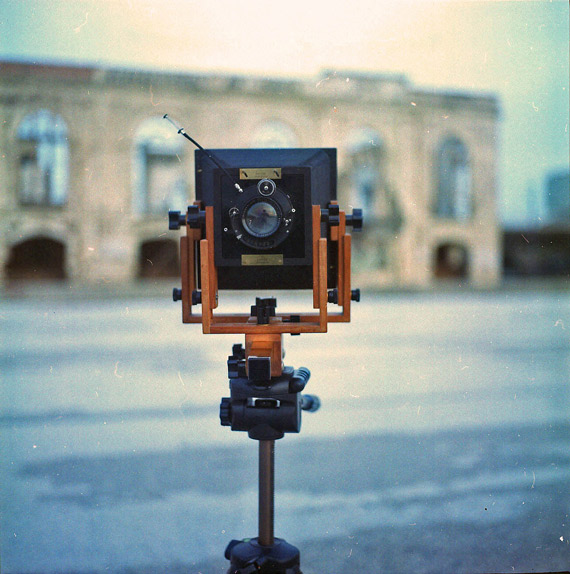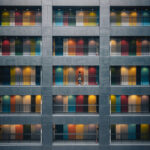Large format cameras are often thought of as difficult to operate, but there’s nothing impossible about using them. If you’re organized and methodical, they’re straightforward, if not exactly simple to use. Many photographers find the idea of using a large format camera daunting because we are all so used to having so much automation in our cameras. Compare a large format camera to a manual, 35mm film camera, and you’ll soon see that there’s a whole new level to manual when you move up to the largest formats.
Most large format cameras are literally no more than an adjustable, light-tight box with film at one end and a lens at the other. There is no metering; nothing is battery powered. The only thing powering the camera is the clockwork shutter. Despite this, working with these big old beasts is perhaps one of the most satisfying experiences a photographer can have. When I use my camera, I feel a real connection to the history of photography and take great pride in being able to produce amazing images without any help from automation. This is “pure” photography.
If you’ve ever toyed with the idea of using a large format camera, or have just bought a camera and haven’t used it yet, then this guide is for you.
What Is Large Format?
Large format is generally considered to start at 4×5 inch sheet film, as the name suggests. Film comes as individual sheets that have to be loaded into holders — a process that would be be familiar to photographers 100 years ago. Large format film gives you two main advantages: 1) the quality is unsurpassed, with images approaching or surpassing the equivalent of 100 MP, and 2) because you shoot single sheets, each sheet can be developed differently to suit the lighting situation you find yourself in.
There are lots of sizes of sheet film, some historical — like whole, half and quarter plate — and others still available today — like 4×5, 5×7 and 10×8. Of these, 4×5 is by far the most widely available and has the most options in terms of film type. Color negative, color slide, and black-and-white film are all available, although the choices in color are a little thin.
Taking Your First Photograph
Unlike smaller formats, there is quite a lot of equipment you need beyond a camera and some film to successfully make a large format photograph. The good news is that most experienced photographers already own a lot of it, and items like dark cloths can be improvised from things around the house. With care, you can put together all the equipment you need for a relatively modest initial outlay, and many of the things you need can be bought secondhand and sold for the same money you paid for them.
Equipment Needed
Large Format Camera
To get started, you should pick a 4×5 camera. The other two common sizes are 5×7 and 10×8, but they’re more expensive, the equipment can be much more difficult to find, and film supply can also be an issue. There are lots of different choices, from expensive, beautifully crafted field cameras to old studio monorails. Lightweight is the quality that tends to cost money, and traditional wooden field cameras go for more than monorails.
Monorails are often the better and more versatile cameras, it’s just that you might give yourself a hernia lugging one into the wilderness. They’re also not as pretty as field cameras, and I’m sure that has an impact! I’m primarily a portrait photographer so I use a monorail, mainly because they focus more closely (i.e. have longer bellows) and are easier to use once set up.
Make sure the camera locks down properly and the bellows are light-tight (shining a torch inside the bellows in a dark room is an easy way to check). Check as well that the camera has enough movements to suit what you will be use it for (this is a complicated subject, but there is plenty of information online).
Lens Board
One of the great advantages of large format is that lenses are pretty much interchangeable between any camera as long as your bellows will focus them.
However, a lens board is needed to mount the lens. These lens boards are simply a flat piece of wood or metal with a hole drilled in them to mount the lens. They tend to be specific to the brand of camera, and come in three main sizes: Copal 0, Copal 1, and Copal 3. The common types are Linhof for field cameras and Sinar for monorails, which are both copied across various makes and brands, although Toyo boards are pretty easy to find, too. Some cheaper secondhand cameras use difficult-to-find lens boards (the reason they’re cheap). If you’re looking to buy one of these, make sure that it comes with the lens boards you need to suit your needs or that the design of the board is simple enough that you can make your own.
Lenses
Generally almost all relatively modern lenses are good. As your first lens, I would recommend going for something in a modern Copal shutter from one of the main manufacturers: Schneider, Rodenstock, Fuji, or Nikon. Your first priority should be putting together a reliable system, so that initial mistakes are easier to diagnose. Something like a lens with an unreliable shutter will cause you endless grief if you’re not already confident in your skills as a large format photographer.
Standard Lenses are around the 150mm mark, but if you’re getting into large format, I will assume you are experienced enough to know which type of lens you want. Just multiply the focal length of your 35mm lens by three to get its large format equivalent.
Tripod
Virtually all large format cameras need to be placed on a tripod to be useable. This is not an area to scrimp on, as a wobbly tripod will cause you endless frustration with blurry shots. As potential resolution goes up, the more meticulous you have to be.
Make sure the tripod you choose is strong enough and tall enough for the camera you choose. One good thing is no one wants humungous, heavy tripods anymore, so they can be found secondhand quite cheaply.
Carbon Fibre is the Rolls-Royce option and very light and stiff, but there have been reports of these tripods blowing over in windy conditions when they have a field camera on them with the bellows extended. The bellows act like a sail, turning your expensive wooden camera into firewood!
Light Meter
Most experienced large format photographers use a handheld meter for establishing exposure — either a spot meter or incident meter, depending on what they like to shoot. However, you can just as easily use a DSLR and transfer the reading to your large format camera or get a light meter app on your smartphone. A DSLR is probably the best method when you’re starting out, as it allows you to “Polaroid” your large format exposure before you expose a sheet of precious film.
You’ll probably find it better to overexpose the film slightly compared to the DSLR reading, but again, I will assume you have some passing familiarity with shooting with film, so I’m sure you have your own preference.
Film Holders
Tip: Check that film holders have good seals and the dark slide is not cracked.
A film holder is essentially a light-tight box that carries two sheets of film. You can usually pick these up secondhand inexpensively, but make sure they are light-tight and in good condition — otherwise you get fogged film, which is expensive and frustrating at this level of photography.
You’ll probably find that five to 10 holders is enough. Modern holders are made of plastic and are pretty bullet proof; some older holders (40 years+) are made of wood and can warp with age, so be careful of this.
Film
There is still a decent choice of film available. The only downside is that color is significantly more expensive than black and white. In the UK, black-and-white film is about £35–£40 for 25 sheets of black and white or £50 for 10 sheets of color film.
To start off with, I would recommend Kodak or Ilford 400 ISO black-and-white film, as it gives you a bit more flexibility with shutter speeds and f-stops, which will help you get sharp pictures when you start.
Film and developing is the most expensive part of the process, but remember if you get everything right, you can produce images that could only otherwise be achieved with a medium format digital back. A system like that will set you back five figures.
A Changing Bag or Darkroom
Film needs to be loaded into the holders in complete darkness. The easiest way to do this if you don’t have access to a darkroom is to purchase a pop-up dark tent. They are about three feet cubed, which is enough space to load film relatively easily on a table in daylight.
Cable Release
The cable release attaches to the shutter to ensure you don’t vibrate the camera during exposure. These are relatively cheap to buy. The main thing to watch for is to make sure the release is long enough so you can stand away from the camera. You can also use your body as a shield to shelter the camera in windy conditions.
A Loupe or Magnifier
This is something you can spend anything between £5 and £200 on! Most popular when starting off are the 8x Agfa or Kaiser slide loupes that can be bought cheaply and will do the job.
A Dark Cloth
Without a dark cloth, it’s nearly impossible to see the focusing screen in bright conditions. If you don’t want to go to the expense, you can use the double T-shirt method. Just put a black T-shirt inside a lighter colour one and use the neck of the shirt to fit around the focusing screen.
A Notebook
It’s important to take notes when shooting with a large format camera. You don’t have metadata with every exposure, and it’s a lot easier to make mistakes. Make sure you write down your exposure, film type, and speed rating, and number your dark slides so that if you have a light leak, you know where it came from!
The Wrap Up
Large format cameras probably offer the most bang per buck than any other camera system. With a bit of ingenuity, you can put together a 100 MP camera system for well under £1000 ($1,484 US), and be able to re-sell it for what you paid. It can also produce images that have a unique look that you can’t replicate with digital and teach you skills that can be applied to produce excellent results in any other camera system.
My Adventure with Large Format Photography
I have been shooting with my large format camera for about four years. I saw a camera in a vintage camera shop and just fancied giving it a go. I mainly shoot portraits. Such as my vintage girls portrait project. There is something inspiring in using methods that Victorian photographers would be pretty familiar with.
In the age of digital photography, I don’t think we care enough about the long history of film photography or the pleasure and satisfaction that learning and using those skills gives us. I like to do my little bit to keep these skills alive. My main work in photography is as a wedding photographer, and I can shoot a thousand images in a day, so large format photography is a great way for me to separate the photos I take for my career and those I shoot for fun.
About the Author
Tobias Key is a professional photographer based in Chichester, West Sussex. If you would like to see some of his work or get more great hints and tips, visit http://www.tobiaskey.com.
Like This Article?
Don't Miss The Next One!
Join over 100,000 photographers of all experience levels who receive our free photography tips and articles to stay current:











Can I get this information on my email address
Mike, I wish to thank you for your clear and concise explanation of concerns/considerations one should ponder before going to large format. The inclusion of this information is extremely helpful to newcomers to large format film cameras. It is information like this that, makes sights like this so helpful.
Thanks man;
James
I have owned numerous 4×5 view cameras… all the way from a build it yourself kit to a Sinar P system. There are a few things about larger cameras which will drive you nuts if you don’t avoid them.
1) You have to hold the camera perfectly still. This means a substantial stand/tripod, a good head (stay away from ball heads) with adequate surface area to mount a big camera, and patience to release the shutter without disturbing the camera. The weight of the camera (vertical or horizontal) needs to be over the center post of the tripod not flopped over 5 to 7 inches off center.
2) Lenses. The good ones are big and heavy. The little ones will not give you sharp corners or allow movements (which is why you are messing with a view camera in the first place.
3) Selection of the camera itself. More money does not always equal a better camera but it might. You want a camera that will stay where you put the adjustments and not sag as you let go due to the weight of film holders and the lens. This is the most troublesome thing about light weight, less expensive cameras. Think “gears” for adjustments. The Sinar P is of course the top of the heap but so heavy you don;t want to take it on a field shoot.
4) Cleanliness. You have 20 square inches (or more) for dust to collect. You don’t need a “clean” room but close. And the camera bellows loves dirt. So you will need to get a good case/bag and learn to load film in a dust free environment. When I traveled and needed to load film I tried to wait until night. Star light (no moon) won’t fog ISO 64/80/100 film but you can still see what you are doing… I usually used the motel room bathroom. I kept the film in a cooler type carrier in zip lock bags. Then to load I ran the shower hot enough to make steam for a few minutes. Turn off the water, shut the door and wait for the room to clear (no fan). Then (making sure all surfaces are dry) you set up and turn off the lights. Load the holders, and put them into groups of 4 to 6 inside zip lock bags and then into the cooler. The steam knocks all the dust out of the air and you almost have a clean room.